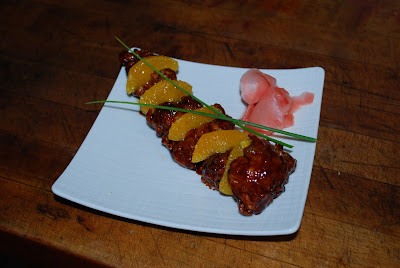
 It is unclear how the dish came to bear the name of Zuo Zongtang , a Qing Dynasty general from Hunan. Zuo himself is unlikely ever to have tasted the dish. The dish is not found in Changsha, the capital of Hunan. Nor is it found in Xiangyin, the home of General Tso. Moreover, descendants of General Tso still living in Xiangyin, when interviewed, say that they have never heard of such a dish.
It is unclear how the dish came to bear the name of Zuo Zongtang , a Qing Dynasty general from Hunan. Zuo himself is unlikely ever to have tasted the dish. The dish is not found in Changsha, the capital of Hunan. Nor is it found in Xiangyin, the home of General Tso. Moreover, descendants of General Tso still living in Xiangyin, when interviewed, say that they have never heard of such a dish.There are several stories concerning the origin of the dish. In her book The Chinese Kitchen, Eileen Yin-Fei Lo states that the dish originates from a simple Hunan chicken dish, and that the reference to "Zongtang" in "Zuo Zongtang chicken" was not a reference to Zuo Zongtang's given name, but rather a reference to the homonym "zongtang", meaning "ancestral meeting hall" Consistent with this interpretation, the dish name is sometimes (but considerably less commonly) found in Chinese as "Zuo ancestral hall chicken" (Chung tong gai is a transliteration of “ancestral meeting hall chicken” from Cantonese; Zuǒ Zōngtáng jī is the standard name of General Tso's chicken as transliterated from Mandarin.)
According to several sources, the recipe was invented by Taiwan-based, Hunan cuisine chef Peng Chang-kuei who had been an apprentice of Cao Jingchen's, a famous early 20th century Chinese chef Peng was the Nationalist government banquets' chef and fled with Chiang Kai-sheks forces to Taiwan during the Chinese civil war There, he continued his career as official chef until 1973, when he moved to New York to open a restaurant That was where Peng Jia started inventing new dishes and modifying traditional ones; one new dish, General Tso's chicken, was originally prepared without sugar, and subsequently altered to suit the tastes of "non-Hunanese people The popularity of the dish has now led to it being "adopted" by local Hunanese chefs and food writers, perhaps as an acknowledgment of the dish's unique status, upon which the international reputation of Hunanese cuisine was largely based.Ironically, when Peng Jia opened a restaurant in Hunan in the 1990s introducing General Tso's chicken, the restaurant closed without success because the locals found the dish too sweet.
General Tso's Chicken commonly consists of dark-meat pieces of chicken that are battered, deep-fried and seasoned with ginger, garlic, soy sauce, rice vinegar, Shaoxing wine or sherry sugar, sesame oil, scallions, and hot chili peppers and often served with steamed broccoli.
Though relatively inexpensive to produce, General Tso's chicken is often listed as a "Chef's Specialty" at Chinese restaurants in North America, commanding a higher price than other items. Many restaurants, especially in areas with many vegetarians, also serve General Tso's Tofu or General Tso's Veg [Other variants substitute shrimp, beef, or even pork for the chicken.
Though relatively inexpensive to produce, General Tso's chicken is often listed as a "Chef's Specialty" at Chinese restaurants in North America, commanding a higher price than other items. Many restaurants, especially in areas with many vegetarians, also serve General Tso's Tofu or General Tso's Veg [Other variants substitute shrimp, beef, or even pork for the chicken.
In this case i've used Veal sweet breads.
No comments:
Post a Comment